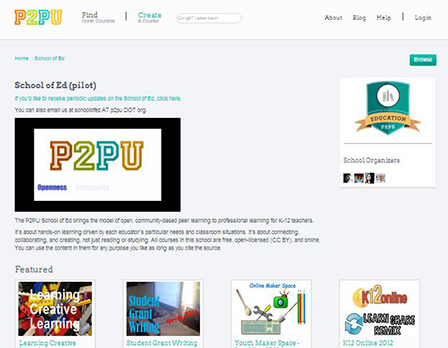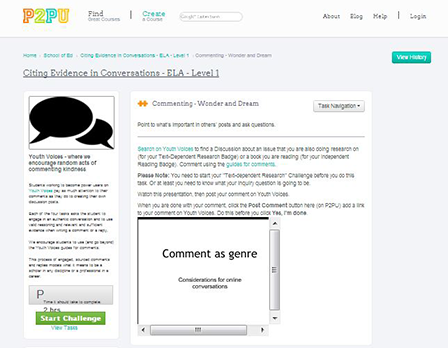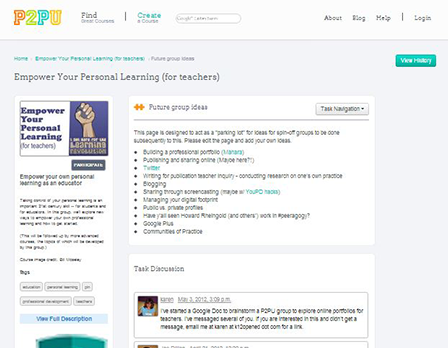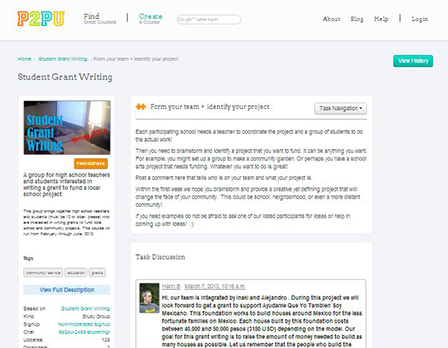#Introduction
Many of the professional development experiences available to K-12 educators are lackluster; at their worst, they can be uninspiring, inauthentic, and ineffective. At it’s best though, professional learning can be stimulating, inquiry-driven, and powerful. It can ignite the lives of both teachers and learners. The question then is, how can teachers be helped to spend more time in these rich experiences? What is it that sets these experiences apart?
The impetus behind deeper professional learning is to apply the ideas of inquiry, self-direction, critical thinking, and collaboration to the professional learning available to educators in order to have experiences that enrich their learning and that of their students.
After all, if teachers don’t participate in this kind of learning, how can they be expected to understand and apply it in classrooms?
A couple years ago, I began to take a closer look at my own experiences in professional development, both as a participant and as a facilitator, and found them to be lacking.
Too often I found myself standing on a literal stage suggesting that such methods were less than optimal in participants’ own learning environments. Too often the workshop agendas were being set by the district administration with little or no input from participants. Too often there was not enough time for meaningful group discussion, collaboration, and hands-on work, and too little follow-up after the main event.
#School of Ed
This led me to explore other learning models, in particular peer learning in open spaces. Through Peer 2 Peer University (P2PU), I found a model of learning that was participant-driven, community-based, and open (in all senses of the word). While my first experiences with this model were not in the education space, I soon began to see the obvious application to professional learning for teachers.
And so began the P2PU School of Education. We started with a small amount of funding from the Hewlett Foundation and some basic ideas of what we wanted to do – provide authentic, peer learning experiences for K-12 teachers around high interest topics.
In the fall of 2011, we launched our first seven courses. The topics included: Student Engagement, Teaching in Online and Blended Classrooms, OER in the K-12 Classroom, Differentiating Instruction, Using Web 2.0 and Social Media to Encourage Deeper Learning, Writing and the Common Core, and Multimedia and Graphics to Facilitate Deeper Learning. Each of these courses was developed and facilitated by an educator with expertise in the area.
Living Up To (and Defying) Expectations
These courses were well received. Some of our initial premises were proven out. The learning was extremely social, and high quality facilitation was critical. Among our richest experiences were the asynchronous online discussion threads and the synchronous gatherings via web-based tools like G+.
Together, we explored and negotiated the meaning of the topics we were studying and worked together to apply it to our own learning contexts.
Other suppositions we had were not supported. Surprisingly, the high quality content we had invested in developing was not the most important part of these groups. In fact, participants valued the conversations they had with peers more than anything else.
And some of these discussions prompted participants to suggest their own course-related collaborative activities that were far more useful than the ones we as developers had originally planned.

Facilitation is Critical
Similarly, we found that the most important instructor/facilitator skills were not necessarily content expertise, but rather community building and group facilitation ability. Contrary to what we originally supposed, a high level of content expertise on the part of facilitators may even dampen the peer learning experience, as participants are more prone to want to be “taught” by the experts, rather than fully engaging in the peer experience.
One challenge we ran into, not uncommon for online learning, was sustaining participation levels. Participation seemed at times to be sporadic or declining; however, when we probed deeper, we found that there were a significant number of “lurkers” who were gaining value from the course, despite their apparent lack of active, visible participation.
As we’ve offered more courses and groups over time, we have come to understand that peer learning is a new experience for many people. Self-direction in learning is often not a natural or comfortable task for those who are not practiced in it. In fact, we launched a study group to look specifically at this, which was called Empowering Your Personal Learning. This kind of participant-inspired, inquiry-driven group has prompted some of the most successful learning groups.
#What We’ve Learned
Almost two years and 30 or so courses later, there are many things that we have learned in this grand experiment.
First, in our experience, the formation of community has been critical. The social nature of peer learning relies on trust and relationships. This is not something that can be fostered over a few weeks. While this kind of community-building takes time, we are beginning to see some evidence of it at P2PU. In large part this has been due to the ongoing, generous participation of many individuals, as well as organizations such as the National Writing Project. We have benefitted greatly from the participation of their already-existing community of passionate and deep thinking educators who share our values and goals.
We have also learned that peer learning experiences work best when they are designed by the group, not instituted from the top down. This can be challenging to achieve, but the groups that have been co-planned and co-facilitated collaboratively have been most compelling.
We’ve found that diverse groups of learners add to the conversation. At P2PU, we have significant international participation, as well as that from various disciplines and professions. Even for groups that deal with what appear to be U.S.-centric topics, like the Common Core, having this diversity of participants has made the conversations richer.

In terms of logistics, shorter courses (three to four weeks) seem better able to maintain momentum, while still giving enough time for in-depth exploration.
These shorter courses can then spin off into more in-depth, follow-up explorations. A defined start and end time has also seemed to encourage participation, as opposed to an open, rolling enrollment.
Learning for Students and Teachers
One of the most pleasant surprises at the School of Ed has been the advent of peer learning groups with students and teachers involved together. Harry Brake from the American School Foundation in Mexico City started a project on P2PU in which students write grants to fund community service projects that they design. This was inspired by a face-to-face project that Mr. Brake had started in Delaware. Now, with this project being online, teachers and students from other parts of the world, as well as a variety of non-profit organizations, have connected and participated.
Another creative and ground-breaking educator, Paul Allison, from the Bronx Academy Senior High, has extended his curriculum through the P2PU community as well. Mr. Allison is a co-founder of Youth Voices. Youth Voices is a school-based social network that encourages students to write about their passions, connect with other students, comment on each other’s work, and create multimedia about topics that are important to them. This is deeper learning in action.
The Youth Voices project has recently been expanded to be a full, Common Core-aligned curriculum in English Language Arts, Social Studies, Arts and Media, and Science. Through this, students are completing projects on subjects of their own choosing at their own pace and direction. Mr. Allison has designed and incorporated badges into this through the P2PU community. For their work, students are awarded badges that count for credit toward graduation. While some call this a gamification of education, one of Mr. Allison’s students, Anthony, aptly pointed out that “this is no game.” These students are doing in-depth projects that not only develop core academic skills, but hone important deeper learning skills of collaboration, communication, critical thinking, self-direction, and persistence.

While students are clearly benefitting from this, teachers around world are also benefitting. We’re seeing how an innovative approach like this can work. We’re thinking through complex issues like how deeper learning can be aligned to the Common Core, how student self-direction can be prompted and tracked, and how assessment and credit can be tied these projects.
Through this important work, we’ve seen that online collaborations with teachers and students can be powerful. And as in my face-to-face experiences, I’ve seen that students often drive the innovation in formal educational environments.
This is a promising area for further development at P2PU.
#Challenges and Puzzles
As much as we’ve learned over the course of this experiment, we still have even more to figure out.
One issue that we’ve wrestled with is the open nature of our learning community. Openness can mean many things, and at P2PU it includes having open-licensed (Creative Commons) content that can be freely shared, remixed, and redistributed; having enrollment that is free and open to anyone in the world; and having group activities be freely viewable on the Internet and not behind firewalls. We believe that this kind of openness and transparency encourages a kind of participation that is uniquely beneficial.
However, we also recognize that for those who are new to peer and online learning, this openness can be unnerving. In fact, other communities have reported that openness like this can actually discourage participation by some. This is a conundrum we have not resolved.
Maintaining Momentum
Another question that plagues many online communities including ours is how to sustain momentum. Teachers are under unprecedented time pressures and finding the time to participate in extra professional learning opportunities like these is difficult. At the present, participation at the P2PU School of Ed, for both participants and facilitators, is an opt-in, volunteer activity.
This connects to the challenge of how to give formal recognition for participation in this professional learning. Currently, P2PU offers neither formal university continuing education credits, nor stipends, for participation. We have considered this at great length and pondered the pros and cons. To offer stipends in some ways seems to run counter to the intrinsic motivation inherent in this kind of learning.
Many of us have seen the sometimes detrimental effects of professional development that is offered on a pay-for-attendance basis. On the other hand, teachers certainly should be adequately compensated for the important work they do, and most district pay schedules do not provide this.

Securing university credit for participation in our courses also has its challenges. Initial pursuits toward this highlighted some of the differences between informal and formal learning, such as participation measures (seat time vs. a competency measure), the role of a syllabus (predetermined and unchanging vs. “hack the syllabus” and make it up as you go), assessment measures (traditional vs. authentic), and even facilitator qualifications (traditionally certified vs. peer facilitators). For the present time, we have decided that the compromises we might have to make to be certified to grant formal credit may not be worth the trade-offs. And still, we recognize that teachers need this formal credit to be recertified and to advance on the salary scale.
We have also pondered the potential intersections between informal learning, such as that happening at P2PU, and formal learning, including the many district-provided professional development in-services. We would love to see some districts begin to experiment with deeper professional learning within their institutions. The P2PU platform is free to use, and all the content already housed there is open licensed. We are willing and eager to collaborate with K-12 organizations who might want to experiment with applying this model to their own learning needs.
#An Invitation
We see the P2PU School of Ed as an on-going experiment for looking at deeper learning in a professional context. We invite anyone who is interested in this area to join us.
There are many ways to participate including joining an existing group, suggesting a topic for a new group, co-designing a group with us, or co-facilitating a group.
We believe that deeper professional learning has the potential to change not only how we learn as adults, but also to affect how we facilitate learning with students.
...
A version of this report first appeared in UnBoxed, Issue 10, Spring 2013
“If teachers don’t participate in learning, how can they be expected to understand and apply it in classrooms?”
...
“We believe that openness and transparency encourages a kind of participation that is uniquely
beneficial. However, we also recognize that openness can be unnerving.”
...
“Many of us have seen the sometimes detrimental effects of professional development that is offered on a
pay-for-attendance basis.”